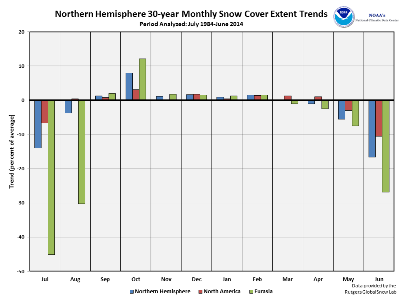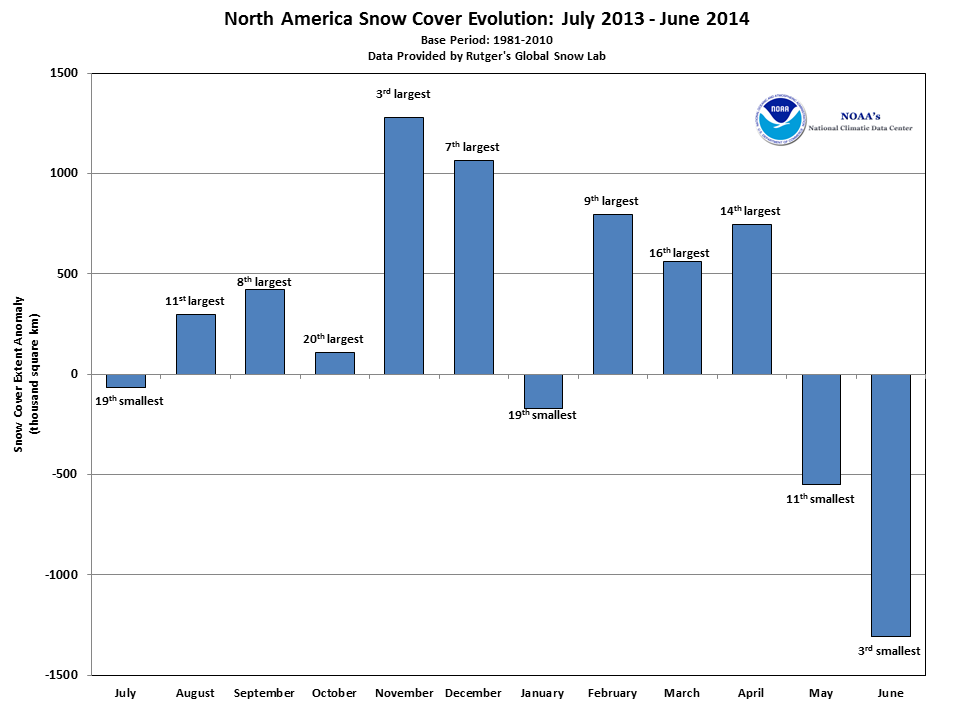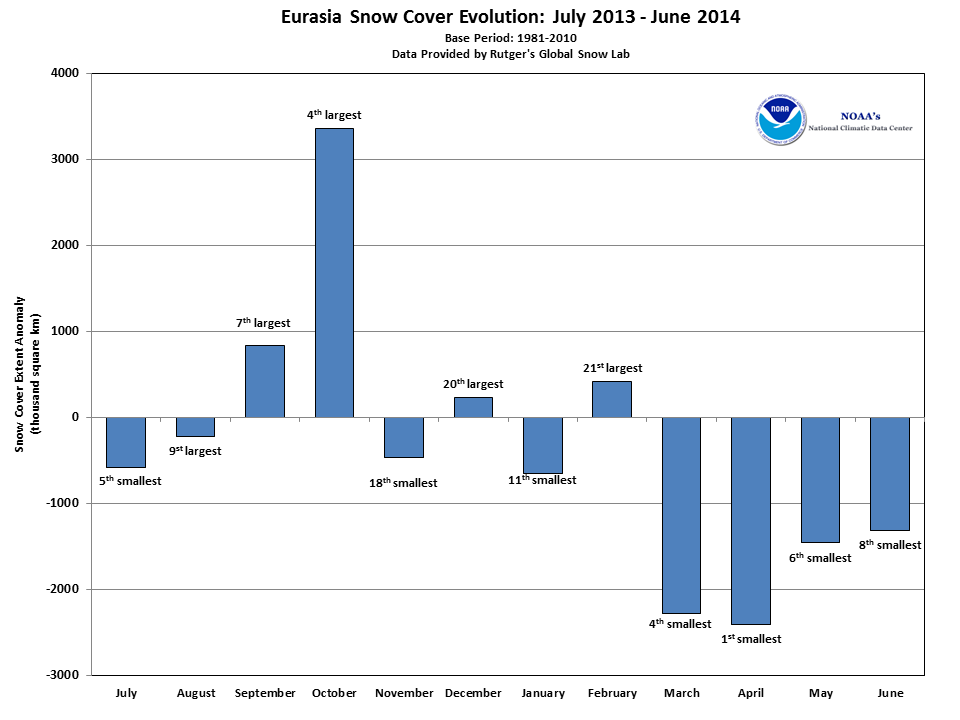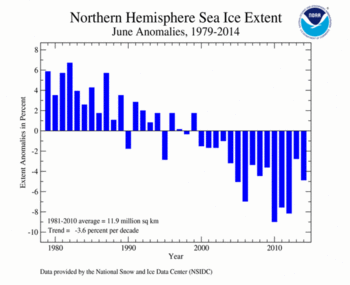Northern Hemisphere Snow Cover Extent — Year in review
The Northern Hemisphere snow year is defined as July 1 through June 30. Throughout the 2013/14 snow year, the monthly Northern Hemisphere snow cover extent (SCE) had large fluctuations. During mid-summer 2013, Northern Hemisphere SCE was one of the 10 smallest in the 1967-present period of record, but expanded to one of the 10 largest during the autumn and early winter. By late-winter and into the summer season, the Northern Hemisphere SCE once again contracted back to one of the 10 smallest extents. During the 12-month period, no month had a record large or record small SCE; however, some record- and near-record breaking snow extents occurred on the continental and sub-continental level. The graphics below illustrate how SCE changed through the 2013/14 snow year across the Northern Hemisphere. For both the Northern Hemisphere and the continents (North America and Eurasia), SCE has been slightly increasing during the autumn and winter seasons, but dramatically decreasing during the spring season over the 1967-2014 period of record.
Data provided by Rutgers Global Snow Lab.
Sea Ice Extent
| June 2014 | Sea Ice Extent | Anomaly 1991-2020 | Trend per decade | Rank (36 years) | Record | ||||
|---|---|---|---|---|---|---|---|---|---|
| million km² | million mi² | Year(s) | million km² | million mi² | |||||
| Northern Hemisphere | 11.03 | 4.26 | -2.39% | -3.98% | Largest | 32nd | 1979 | 12.53 | 4.84 |
| Smallest | 5th | 2010 | 10.59 | 4.09 | |||||
| Southern Hemisphere | 14.69 | 5.67 | +9.14% | +1.93% | Largest | 1st | 2014 | 14.69 | 5.67 |
| Smallest | 36th | 2002 | 12.38 | 4.78 | |||||
| Globe | 25.72 | 9.93 | +3.88% | -0.77% | Largest | 5th | 1979 | 26.72 | 10.32 |
| Smallest | 32nd | 2002 | 23.96 | 9.25 | |||||
Data Source: National Snow and Ice Data Center (NSIDC). Period of record: 1979–2014 (36 years)
According to the National Snow and Ice Data Center (NSIDC), the Northern Hemisphere (Arctic) sea ice extent — which is measured from passive microwave instruments onboard NOAA satellites — averaged for June 2014 was 11.31 million square km (4.37 million square miles), 580,000 square km (220,000 square miles), or 4.9 percent, below the 1981-2010 average. This was the sixth smallest June Arctic sea ice extent on record. The rate of ice decline during June across the Arctic was faster than average, with sea ice retreating most rapidly towards the end of the month. According to the NSIDC, large areas of the Laptev Sea became ice free during June, with below-average ice cover also observed in the Barents Sea, Hudson Bay, and the East Greenland Sea. The Kara Sea, which has experienced much-below-average sea ice during the past several summers, had closer to average sea ice extent during June 2014. However, the ice extent in this region was still below the 1981-2010 average. Overall, June Arctic sea ice extent is decreasing at an average rate of 3.5 percent per decade.
The June 2014 Southern Hemisphere (Antarctic) sea ice extent was 15.26 million square km (5.89 million square miles), 1.33 million square km (510,000 square miles), or 9.6 percent, above the 1981-2010 average. This was the largest Antarctic sea ice extent on record, surpassing the June 2010 Antarctic sea ice extent by 260,000 square km (100,000 square miles), an area approximately the size of New Zealand. This also marked the 18th consecutive month with much above-average sea ice extent in the Southern Hemisphere and the third consecutive month with record large sea ice. Seven of the last 12 months have had record large sea ice extent in the Southern Hemisphere. Above-average sea ice extent occurred in the Amundsen Sea and the southern Indian and Atlantic Oceans, from the Weddell Sea, eastward. Slightly below-average sea ice extent was observed on either side of the Antarctic Peninsula. Southern Hemisphere sea ice extent during June is increasing at an average rate of 1.7 percent per decade.
When combining the Northern and Southern Hemisphere sea ice extents, the globally-averaged sea ice extent during June was 26.57 million square km (10.26 million square miles), 2.9 percent above the 1981-2010 average and the third largest June global sea ice extent on record. Only the June global sea ice extents during 1979 and 1982 were larger. Global sea ice extent during June is decreasing at an average rate of 0.7 percent per decade.
For further information on the Northern and Southern Hemisphere snow and ice conditions, please visit the NSIDC News page.
 NOAA's National Centers for Environmental Information
NOAA's National Centers for Environmental Information





